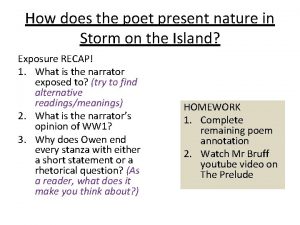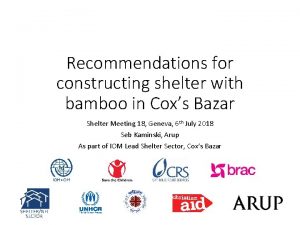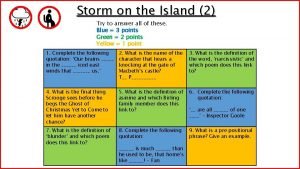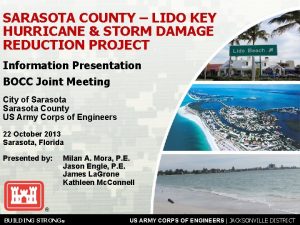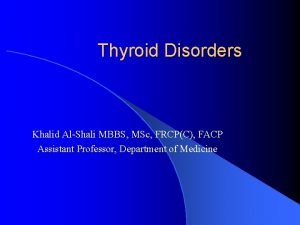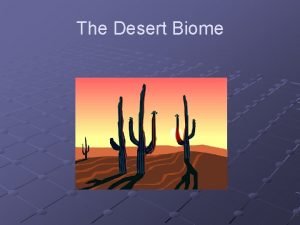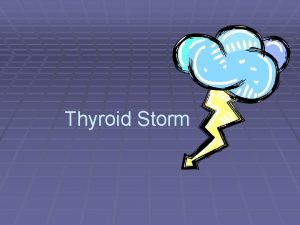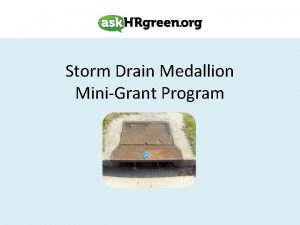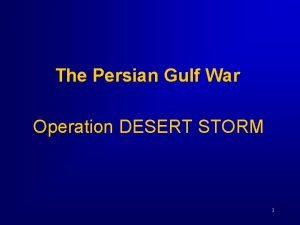OPERATION DESERT STORM What is Operation Desert Storm









- Slides: 9

OPERATION DESERT STORM

What is Operation Desert Storm? ■ Operation Desert Storm, also known as the Gulf War. The U. S. responded to Iraq’s attempt to overwhelm and surprise their neighboring country Kuwait’s liberation in 1991 had allowed better military technology to use in the battlefield. Most of the battles took place in Kuwait, Iraq, and underlying parts of Saudi Arabia using combat and aerial methods.

History ■ Kuwait had become a British Protectorate in 1889 (Protectorate means a state that is controlled and protected by another). British forces began to stop protecting Kuwait in 1961. On June 19, 1961, British protection ended and Kuwait joined the Arab League (The Arab League was founded in and included the Kingdom of Egypt, Kingdom of Iraq, Lebanon, Saudi Arabia, Syrian Republic, Jordan, Yemen). Iraq objected strongly and claimed that Kuwait was part of their territory. Later, Kuwait formed its own constitution. By January 23, a national assembly was elected in Iraq. By October, 1963, Iraq gave up its claim on Kuwait. Iraqi dictator Saddam Hussein wanted to regain that lost land for Iraq, and so he invaded.

Close to the War ■ Around 1990, Iraqi forces invaded Kuwait; however, such an unexpected invasion caught the world in shock. The dictator, Saddam Hussein, had conducted numerous amounts of threats towards Kuwait before the actual invasion. Those who expected the invasion and attack were in shock due to the magnitude. Commander of U. S. central command, Norman Schwarzkopf, expected a limited attack to seize Kuwaiti oil fields. Instead, within a number of hours, Iraqi forces had seized downtown Kuwait City and were headed south toward the Saudi Arabia border.

How was America involved? ■ Word of the Iraqi attack reached Washington, D. C. , as Iraqi forces gathered at the Saudi border. The Saudi’s had requested for aid; however, the U. S. went on standby. Secretary of Defense Dick Cheney and General Schwarzkopf met with King Fahd of Saudi Arabia to brief him on the plans, which he approved. Within minutes of the meeting, orders were issued, and thus began the largest buildup of American forces since the Vietnam War. ■ By the end of September 1990, there were nearly 200, 000 American personnel in Saudi Arabia -- enough to repel any Iraqi attack. ■ The initial plan to drive Iraqi forces from Kuwait called for a direct offensive aimed at Kuwait City; but Schwarzkopf and other American commanders thought that the risk was too great against heavily armed, well-entrenched defenders. Instead, they called for additional troops to prepare for the largest military cleanup ever seen.

The Superior Power ■ American forces first destroyed Iraqi border radar stations, then other key elements of the Iraqi anti-aircraft network; lastly, they began to bomb key targets in downtown Iraq, including the presidential palace, communication centers, and power stations. The Allied forces lost only two aircraft during the attacks. This was known as, Operation Desert Shield. ■ The damage done by U. S. air attacks was devastating to Saddam's vaunted Republican Guard. ■ On January 17, the Iraqis fired seven Scud missiles at Israel. To avoid a wider war, U. S. officials pleaded with Israeli officials to not respond to the Scud attacks. The Israelis agreed because the Americans promised to target all Scud missile sites and knock them out.

The Three Days ■ Day One - The Allied troops led by U. S. Marines crossed the border into Iraq. During the days before the attack, Iraqi troops had been subjected to merciless air attacks. (They were already weak). ■ Day Two - With morale nevertheless high, American troops advanced on all fronts. The marines approached Kuwait City, while the western flank began to cut off the Iraqi Army's retreat route. ■ Day Three - Also known as the largest tank battle in history. The American armored forces engaged the tank forces of the Iraqi Republican guard. American tanks destroyed the Iraqi heavy armor without losing a single tank ■ One hundred hours after the ground campaign began, President Bush declared a cease-fire — declaring the liberation of Kuwait on February 27, 1991.

Post-War ■ President Bush announced that U. S. relief supply airdrops would be made to Kurdish refugees in Turkey and northern Iraq. After Iraq issued its acceptance of a cease-fire, Task Force Provide Comfort was formed and deployed to assist the Kurds. By war's end, U. S. forces released 71, 204 Iraqi prisoners to Saudi control

Casualties ■ U. S. Casualties: Resulting in 148 U. S. battle deaths, and 145 nonbattle deaths, including 15 women. Wounded in action: 467 ■ Iraqi casualties: 300, 000 were wounded and 545, 000 troops in the Kuwait theater of operations, an estimated 100, 000 were killed, and


